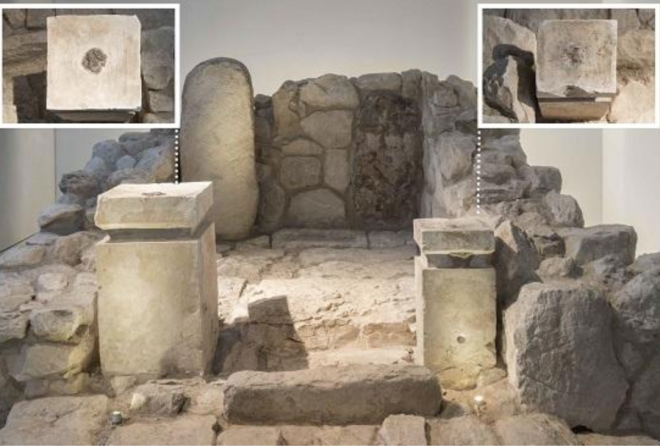
Front view of the shrine at Arad, rebuilt in the Israel Museum. The top down view of the altars show where you can see the black residue of cannabis and frankincense.
A Holy High? It was often suspected to be part of religious rights. And cannabis or medical marijuana is being applied today in Israel to fight COVID-19. For the first time archeologists reveal that psychoactive cannabis was part of ancient worship rituals in the Holy Land.
Analysis of the material on two Iron Age altars discovered at the entrance to the “holy of holies” of a shrine at Tel Arad in the Beer-sheba Valley, Israel, were found to contain traces of cannabis and frankincense, according to new article in the journal, Tel Aviv.
Lead author Eran Arie from The Israel Museum in Jerusalem commented, “This is the first time that cannabis has been identified in the Ancient Near East; Its use in the shrine must have played a central role in the cultic rituals performed there.”
These unique findings shed new light on cult practices in biblical Judah, suggesting cannabis was used here as a deliberate psychoactive, to stimulate ecstasy as part of cultic ceremonies. Today people use CBD hemp oil for pain relief. Back then, the CBD and THC might have been part of a smudging ceremony.
Frankincense comes from Arabia. Therefore, the presence of frankincense at Arad indicates the participation of Judah in the south Arabian trade even before the patronage and encouragement of the Assyrian empire. Arad provides the earliest evidence for frankincense in a clear cultic context. Frankincense is mentioned as a component of the incense that was burned in the Temple of Jerusalem for its pleasant aroma. Today it’s used along with the cannabis plant as a popular smudge people use to clear the energy in their homes or offices.
Past excavations revealed two superimposed fortresses, dated to the 9th to early 6th centuries BCE, which guarded the southern border of biblical Judah. Highly important Iron Age finds were unearthed, including a well-preserved shrine that was dated to ca. 750-715 BCE.
Two limestone altars (the smaller altar is 40 cm high and about 20 × 20 cm at the top; the larger is about 50 cm high and 30 × 30 cm at the top) were found lying at the entrance to the “holy of holies” of the shrine.
Evidently, they had played an important role in the cult practices of the shrine. An unidentified black solidified organic material was preserved on the altars’ surfaces. Past analysis of these materials failed to identify their content and this dark material was recently submitted to organic residue analysis by modern methods.
The study reveals that on the smaller altar cannabis had been mixed with animal dung to facilitate heating, while the larger altar contained traces of frankincense that was mixed with animal fat to promote evaporation.
The “fortress mound” of Tel Arad in the Beer-sheba Valley in southern Israel was excavated over 50 years ago under the direction of the late TAU Professor Yohanan Aharoni.
Photo credit: Collection of the Israel Antiquities Authority, Photo © The Israel Museum, by Laura Lachman



